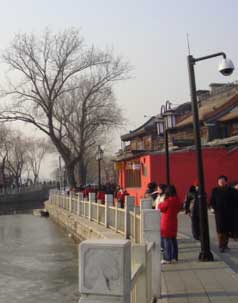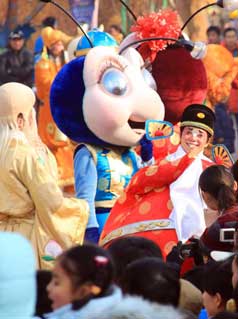Over the holiday, China.org.cn recruited seven Chinese people and seven foreigners, paired them into seven teams, and sent them to around Beijing to seek out authentic Spring Festival experiences. The idea was that the Chinese would explain the background of the festival to the foreigners although occasionally it turned out the other way round. Everyone filmed or wrote up their stories after the trip.

Thousands of people gathered at Beijing's Temple of Heaven on a chilly winter afternoon to watch the park's latest effort to create a living past for one of China's most spectacular sights. Twice a day during the Spring Festival New Year's holiday, a modern-day surrogate for the Qing dynasty emperor (Qianlong is perhaps the best known outside China) marches solemnly with his guards along a portion of the broad Danbi bridge that links the northern and southern parts of the huge temple complex.
The Heavenly Worship Ceremony takes you back hundreds – even thousands – of years. The one that is particularly relevant to me is now conducted by actors in the 21st century to celebrate the Chinese New Year and pray for the prosperity of the whole nation. The ceremony takes place in Tiantan Park (Temple of Heaven). Hundred-year-old trees grow tall and thick, their branches black and sharp against the sky. You pass from them into a traditional Chinese cloister which extends as far as the eye can see, losing itself in the distant shadows. The beauty and variety of the stall-holders crying their wares, the bolang drums of the sellers of Spring Festival goods, and the loud laughter from the children, all clash and blend with each other in perfect harmony, like a Peking Opera.

As a certifiable zhongguotong who has lived in Beijing for nearly 7 years now, this was not my first visit to a temple fair, and I usually try to visit the Ditan temple fair each year. This year I was to meet a Chinese girl, Jessica, who was also assigned to write a story about visiting the Ditan temple fair. We'd arranged to meet up at the Yonghegong subway station at 9:00am, so after a big breakfast of oatmeal and earl grey tea, I put on my 4 layers of clothing (temple fairs are cold!) and went down to the subway.
Strolling through a temple fair is quite the traditional thing to do during Spring Festival in China. But even though I am Chinese I went to a temple fair for the first time in my life on February 27 this year. I got up early on that sunny morning and took a taxi to the Ditan Temple Fair. The taxi driver was a native Beijinger and very passionate about Beijing and its people. On the way to Ditan he told me all about Beijing from the Qing Dynasty down to today. It was the start of a happy day.

Capital museum is always my favorite place to go during holidays. I like the grand black building and I like the different and varied exhibitions they put on. Today, before I even enter the museum, I can already feel the festive atmosphere. Red carpets cover the center stairs, and on both sides of the carpets are lovely figurines in a series of postures offering their greetings to visitors. Counting the figurines, we find ourselves in the museum; there are so many people in the lobby, and crowds are everywhere. Down in the basement is the exhibition that we are so looking forward to. The name of the show in Chinese is quite interesting; it's called "Niu Shuo Niu" – literally translated as "Ox speaks Ox". I think it means "Let the ox itself tell you about the culture of the ox", though the actual English name of the show is "Cattle in the traditional culture of China".
Almost everywhere you look these days - you see a cow . It is the Year of the Cow after all. But wait, is it the year of the cow or the year of the ox? While visiting the Capital Museum's Spring Festival exhibition this week with friends, I was surrounded by many sculptures, statues and pictures of cattle. But I started to wonder what are the differences and similarities of the two animals?

On a late winter's day, we ventured out for a look at Houhai. With a light breeze and a bit of sunshine, the scene was dominated by numerous figures dragging themselves over the ice on sleighs, rather too slow for my liking, while others were walking around casually or window shopping on the pathways surrounding the frozen lake. It seemed like a beautiful winter's day.
For a genuine flavor of old Beijing, take a trip to the hutongs around the Houhai district, where a new generation of stylish bars and restaurants has revitalized an ancient neighborhood. In recent years the district has become very popular with tourists from all over the world. Houhai is a lake in central Beijing, sandwiched Qianhai to the south and Xihai, to the north – which together make up the area known as Shichahai. Houhai is a great place for tourists all year round. At Spring Festival, the most important holiday in the Chinese calendar, its totally differentiated style, scene and feeling create a unique experience for visitors to enjoy.

This year as part of China.org's Spring Festival activity I spent the first day of the year of the Ox at Happy Valley with my partner, Puerto Rican William Den-Chao. It was an awesome beginning to the year. It is my first Spring Festival in Beijing, and William's first Spring Festival in China. It turned out that many things happened to us for the first time during our day at Happy Valley. Happy Valley chose a traditional theme for this New Year, holding an event reminiscent of Beijing's many temple fairs. Folk performers put on a variety of amazing stunts such as lion dances, a stilt dance, a fire dragon performance -- even a reconstruction of an ancient Beijing street scene.
Spring Festival, also know as Chinese New Year was always a time of great excitement for me because, like may Chinese citizens, it is the time of the year when I return home to Puerto Rico in order to visit my family and escape Beijing's cold weather. This year however I have decided to stay and experience Chinese Spring Festival in Beijing and choose to spend the first day of the Year of the OX at Happy Valley which is a very popular theme park in the Southeast of Beijing.
Copyright © China.org.cn. All Rights Reserved E-mail: webmaster@china.org.cn Tel: 86-10-88828000 京ICP证 040089号




